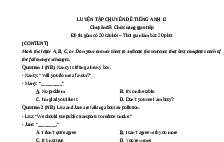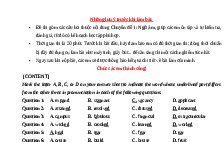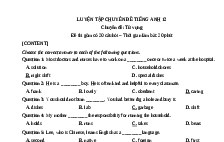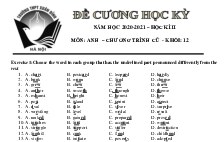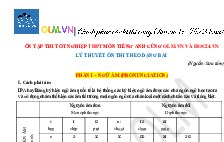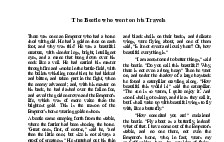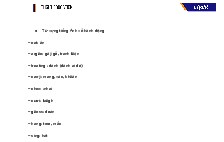[NÂNG CAO ĐỌC HIỂU CHỦ ĐỀ EDUCATION KEY] - MS LIEU PHAM
Nội dung tài liệu
Tải xuống
Link tài liệu:
Các tài liệu liên quan
-
![Đề luyện tập Chuyên đề 3: Chức năng giao tiếp]()
-
![Đề luyện tập Chuyên đề 1: Ngữ âm]()
-
![Đề luyện tập Chuyên đề 2: Từ vựng]()
-
![Tài liệu ôn tập HKII năm học 2020-2021 môn Tiếng Anh 12 chương trình cũ, trường THPT Xuân Đỉnh - Hà Nội]()
-
![Lý thuyết ôn thi THPT môn Tiếng Anh theo dạng bài]()
-
![UNDERSTAND]()
-
![TỪ VỰNG VỀ CÁC MÔN HỌC]()
-
![Tuyển tập truyện ngắn song ngữ Anh-Việt hay]()
-
![Tuyển tập truyện cổ tích bằng tiếng Anh]()
-
![TỪ VỰNG VỀ HÀNH ĐỘNG]()
Có thể bạn quan tâm
Thông tin tài liệu
Cô Phạm Liễu – chuyện luyện thi Tiếng Anh
ĐỌC HIỂU CHUYÊN ĐỀ EDUCATION - KEY
EXERCISE 1
EDUCATION IN THE FUTURE
Education is another area of social life in which information technology is changing the way we
communicate. Today's college students may not simply sit in a lecture or a library to learn about their field.
Through their computers and the wonders of virtual reality they can participate in lifelike simulated
experiences. Consider the following scenario of the future of education made possible through developments
in information technology.
For children over the age of 10, daily attendance at schools is not compulsory. Some of the older children
attend school only once or twice weekly to get tutorial support or instruction from a teacher. For the most
part, pupils are encouraged to work online from home. Students must complete a minimum number of study
hours per year; however, they may make up these hours by studying at home at times that suit their family
schedule. They can log on early or late in the day and even join live classes in other countries. In order to
ensure that each student is learning adequately, computer software will automatically monitor the number of
hours a week each student studies on-line as well as that students' learning materials and assessment activities.
Reports will be available for parents and teachers. The software can then identify the best learning activities
and condition for each individual student and generate similar activities. It can also identify areas of weak
achievement and produce special programs adjusted to the students' needs.
Question 1. What is the topic of the passage?
A. The effect of information technology on education.
B. Computer software will make sure students learn at home.
C. Students can know about their weak aspects to focus.
D. Students don't have to go to school any more.
Question 2. How many times are children who are older than 10 required to go to school weekly?
A. no time
B. three times
C. four times
D. once or twice
Question 3. Who/What counts the number of hours per week that students spend learning?
A. Virtual reality
B. Teacher
C. Parents
D. Computer software
Question 4. What CAN'T the software do?
A. Monitor the time the students learn.
B. Design courses for the students.
C. Find out the best activities for the students. D. Identify weaknesses of the students.
Question 5. What is NOT MENTIONED as a benefit of information technology to the students?
A. Students can stay at home to learn.
B. Students can learn at times that suit their schedule.
C. Students' learning time won't be monitored. D. Students' weak achievement can be identified.
ĐÁP ÁN CHI TIẾT
Câu 1. Đáp án A
Chủ đề của bài đọc là gì?
A. Ảnh hưởng của công nghệ thông tin đến giáo dục.
B. Phần mềm máy tính sẽ làm học sinh chắc chắn học ở nhà.
C. Học sinh có thể biết về những điểm yếu họ còn mắc để khắc phục
D. Học sinh không phải đến trường nữa.
Thông tin trong bài: Education is another area of social life in which information technology is changing the
way we communicate.
Giáo dục là một lĩnh vực khác của đời sống xã hội mà ở đó công nghệ thông tin đang thay đổi cách chúng ta
giao tiếp.
Câu 2. Đáp án D
Trẻ em hơn 10 tuổi bắt buộc phải đến trường bao nhiêu lần một tuần?
A. Không lần nào
B. Ba lần
C. Bốn lần
D. Một hoặc hai lần
Thông tin trong bài: For children over the age of 10, daily attendance at schools is not compulsory. Some of the
older children attend school only once or twice weekly to get tutorial support or instruction from a teacher.
Group: https://www.facebook.com/groups/TiengAnhCoPhamLieu/
Cô Phạm Liễu – chuyện luyện thi Tiếng Anh
Với những đứa trẻ hơn 10 tuổi thì việc đến trường hàng ngày là không bắt buộc. Một vài em lớn hơn chỉ đến
trường một hay hai lần một tuần để nhận sự hỗ trợ và hướng dẫn từ giáo viên.
Câu 3: Đáp án D
Ai/ cái gì đếm số giờ trên một tuần mà học sinh dành cho việc học?
A. hình ảnh ảo như thật
B. giáo viên
C. phụ huynh
D. phần mềm máy tính
Thông tin trong bài: In order to ensure that each student is learning adequately, computer software will
automatically monitor the number of hours a week each student studies on-line …
Để đảm bảo rằng mỗi học sinh đều đang học tập đầy đủ, phần mềm máy tính sẽ tự động theo dõi số giờ mỗi
tuần mà học sinh dành để học trên mạng …
Câu 4: Đáp án B
Phần mềm không thể làm gì
A. Theo dõi thời gian học của học sinh
B. Thiết kế các khóa học cho học sinh
C. Tìm ra những hoạt động tốt nhất cho học sinh
D. Phát hiện ra những điểm yếu của học sinh
Thông tin trong bài: In order to ensure that each student is learning adequately, computer software will
automatically monitor the number of hours a week each student studies on-line …
The software can then identify the best learning activities and condition for each individual student and
generate similar activities. It can also identify areas of weak achievement and produce special programs
adjusted to the students' needs.
Để đảm bảo rằng mỗi học sinh đều đang học tập đầy đủ, phần mềm máy tính sẽ tự động theo dõi số giờ mỗi
tuần mà học sinh dành để học trên mạng …
Phần mềm có thể nhận biết được những phương pháp học tốt nhất và điều kiện cho mỗi học sinh và tạo ra những
hoạt động tương tự. Nó cũng có thể nhận dạng được những lĩnh vực mà học sinh đạt kết quả kém và lập ra
những chương trình đặc biệt được điều chỉnh theo nhu cầu của học sinh.
Câu 5: Đáp án C
Điều nào dưới đây không được nói đến như là một lợi ích của công nghệ thông tin đối với học sinh?
A. Học sinh có thể ở nhà học
B. Học sinh có thể học vào những lúc phù hợp với thời gian của họ
C. Thời gian học tập của học sinh sẽ không bị theo dõi
D. Những phần mà học sinh còn kém sẽ được nhận diện
Thông tin trong bài: Dựa vào câu 3 và 4 ta thấy thời gian học của học sinh được theo dõi bởi một phần mềm
máy tính nên đáp án C sai.
EXERCISE 2.
It is commonly believed in the United States that school is where people go to get an education. Nevertheless,
it has been said that today children interrupt their education to go to school. The distinction between schooling
and education implied by this remark is important. Education is much more open-ended and all-inclusive than
schooling. Education knows no bounds. It can take place where, whether in the shower or on the job, whether
in the kitchen or on a tractor. It includes both the formal learning that takes place in schools and the whole
universe of informal learning. The agents of education can range from a reserved grandparent to the people
debating politics on the radio, from a child to a distinguished scientist. Whereas schooling has certain
predictability, education quite often produce surprise. A change conversation with a stranger may lead a person
to discover how little is known of other religions.
People are engaged in education from infancy on. Education, then, is a very broad, inclusive term. It is a
lifelong process, a process that starts long before the start of school and one that should be an integral part of
one’s entire life. Schooling, on the other hand, is a specific, formalized process, whose general pattern varies
little from one setting to the next. Throughout a country, children arrive at school at approximately the same
time, take assigned seats, are taught by an adult, use similar textbook, do homework, take exams, and so on.
Group: https://www.facebook.com/groups/TiengAnhCoPhamLieu/
Cô Phạm Liễu – chuyện luyện thi Tiếng Anh
The slices of reality that are to be learnt, whether they are the alphabet or an understanding of the workings of
government, have usually been limited by the boundaries of the subject being taught. For example, high school
students know that they are not likely to find out in their class the truth about political problems in their
communities or what the newest filmmakers are experimenting with. There are definite conditions surrounding
the formalized process of schooling.
Question 1. What does the author probably mean by using the expression “children interrupt their education to
go to school”?
A. Going to several different schools is educationally beneficial.
B. School vacations interrupt the continuity of the school year.
C. Summer school makes the school year so long.
D. All of life is an education.
Question 2. The word “bounds” is closest in meaning to __________.
A. rules
B. experiences
C. limits
D. expectation
Question 3. The word “they” refers to
A. slices of reality
B. similar textbooks C. boundaries
D. seats
Question 4. The passage supports which of the following conclusions?
A. Without formal education, people would remain ignorant.
B. Education systems need to be radically reformed.
C. Going to school is only part of how people become educated.
D. Education involves many years of professional training.
Question 5. The passage is organized by __________.
A. listing and discussing several educational problems
B. contrasting the meanings of two related words
C. narrating a story about excellent teachers
D. giving examples of different kinds of schools
ĐÁP ÁN CHI TIẾT
Câu 1. Đáp án D
Tác giả có ý gì khi nói rằng “trẻ em bị gián đoạn việc học khi đến trường”
A. Đến học nhiều trường khác nhau là có lợi cho việc học.
B. Những kì nghỉ ở trường làm gián đoạn sự liên tục của năm học ở trường.
C. Trường học vào mùa hè làm cho thời gian học quá dài.
D. Giáo dục là vấn đề của cả cuộc đời.
Thông tin trong bài: It is commonly believed in the United States that school is where people go to get an
education. Nevertheless, it has been said that today children interrupt their education to go to school. The
distinction between schooling and education implied by this remark is important. Education is much more openended and all-inclusive than schooling. Education knows no bounds.
Ở nước Mỹ người ta thường tin rằng trường học là nơi mà chúng ta được giáo dục. Tuy nhiên, gần đây
người ta lại nói rằng trẻ em ngừng việc học hỏi lại để đến trường. Sự khác biệt giữa trường học và giáo dục ẩn
sau lời nhận xét này chứa một hàm ý quan trọng. Giáo dục rộng mở và bao hàm nhiều hơn trường học. Giáo dục
thì không có giới hạn.
Câu 2. Đáp án C
Từ “bounds” gần nghĩa nhất với
A. luật lệ
B. kinh nghiệm, trải nghiệm
C. giới hạn
D. sự mong đợi
Dựa vào gợi ý ta thấy giáo dục vô cùng bao quát và rộng lớn nên đáp án C phù hợp nhất.
Câu 3. Đáp án A
Từ “they” nhắc đến
A. vấn đề thực tế
B. sách giáo khoa giống nhau
C. biên giới
D. chỗ ngồi
Group: https://www.facebook.com/groups/TiengAnhCoPhamLieu/
Cô Phạm Liễu – chuyện luyện thi Tiếng Anh
Thông tin trong bài: The slices of reality that are to be learnt, whether they are the alphabet or an understanding
of the workings of government, have usually been limited by the boundaries of the subject being taught.
Những vấn đề thực tế cần phải học, cho dù là bảng chữ cái hay hiểu biết về cách vận hành của bộ máy
nhà nước, thường bị giới hạn bởi những gì được giảng dạy.
Câu 4. Đáp án C
Bài đọc ủng hộ kết luận nào dưới đây?
A. Không có giáo dục chính thống thì con người vẫn mãi kém hiểu biết
B. Các hệ thống giáo dục cần được cải tổ từ gốc rễ
C. Đi học chỉ là một phần của quá trình học tập
D. Giáo dục bao gồm nhiều năm đào tạo chuyên môn
Thông tin trong bài:
Câu A sai vì
“Education knows no bounds. It can take place where, whether in the shower or on the job, whether in the
kitchen or on a tractor. It includes both the formal learning that takes place in schools and the whole universe
of informal learning.” – “Giáo dục thì không có giới hạn. Nó có thể diễn ra ở bất cứ đâu, dù khi đang tắm hay
khi đang làm việc, dù đang ở trong bếp hay trên xe kéo. Nó bao gồm cả giáo dục chính thống mà diễn ra ở
trường và cả muôn vàn những sự học tập không chính thống.”
Câu B sai vì bài đọc không hề đưa ra những hạn chế của giáo dục hay cách khắc phục.
Câu C đúng vì đây là nội dung xuyên suốt bài: “It includes both the formal learning that takes place in schools
and the whole universe of informal learning.”
Câu D sai vì bài đọc không hề có ý kiến này.
Câu 5. Đáp án B
Bài đọc được sắp xếp bằng cách
A. liệt kê và thảo luận một vài vấn đề trong giáo dục
B. so sánh ý nghĩa của hai từ có liên quan đến nhau
C. kể một câu chuyện về những giáo viên xuất chúng
D. đưa ra những ví dụ về các loại trường học khác nhau
Hai đáp án C và D sai vì không bao gồm nội dung mà bài đọc đề cập đến.
Đáp án A sai vì bài viết không chỉ ra hạn chế của một hệ thống giáo dục cụ thể nào cả.
Đáp án B đúng vì xuyên suốt bài viết là những so sánh giữa 2 từ “education” và “school”.
EXERCISE 3.
Let children learn to judge their own work. A child learning to talk does not learn by being corrected all the
time: if corrected too much, he will stop talking. He notices a thousand times a day the difference between the
language he uses and the language those around him use. Bit by bit, he makes the necessary changes to make
his language like other people’s. In the same way, children learn all the other things they learn to do without
being taught – to talk, run, climb, whistle, ride a bicycle – compare their own performances with those of more
skilled people, and slowly make the needed changes. But in school we never give a child a chance to find out
his mistakes for himself, let alone correct them. We do it all for him. We act as if we thought that he would
never notice a mistake unless it was pointed to him, or correct it unless he was made to. Soon he becomes
dependent on the teacher. Let him do it himself. Let him work out, with the help of other students if he wants it,
what this word says, what the answer is to that problem, whether this is a good way of saying or doing this or
not.
If it is a matter of right answers, as it may be in mathematics or science, give him the answer book. Let him
correct his own papers. Why should we teachers waste time on such routine work? Our job should be to help
the child when he tells us that he can’t find the way to get the right answer. Let’s end all this nonsense of grades,
exam, marks. Let us throw them all out, and let the children learn what all educated persons must someday learn,
how to measure their own understanding, how to know what they know or do not know.
Group: https://www.facebook.com/groups/TiengAnhCoPhamLieu/
Cô Phạm Liễu – chuyện luyện thi Tiếng Anh
Let them get on with this job in the way that seems most sensible to them, with our help as school teachers if
they ask for it. The idea that there is a body of knowledge to be learnt at school and used for the rest of one’s
life is nonsense in a world as complicated and rapidly changing as ours. Anxious parents and teachers say, “But
suppose they fail to learn something essential, something they will need to get on in the world?” Don’t worry!
If it is essential, they will go out into the world and learn it.
Question 1. What does the author think is the best way for children to learn things?
A. by copying what other people do
B. by making mistakes and having them corrected
C. by listening to explanations from skilled people
D. by asking a great many questions
Question 2. What does the author think teachers do which they should not do?
A. They give children correct answers
B. They point out children’s mistakes to them
C. They allow children to mark their own work D. They encourage children to copy from one another
Question 3. The passage suggests that learning to speak and learning to ride a bicycle are _________.
A. not really important skills
B. more important than other skills
C. basically different from learning adult skills D. basically the same as learning other skills
Question 4. Exams, grades and marks should be abolished because children’s progress should only be estimated
by
A. educated persons
B. the children themselves
C. teachers
D. parents
Question 5. The author fears that children will grow up into adults who are _________.
A. too independent of others
B. too critical of themselves
C. unable to think for themselves
D. unable to use basic skills
ĐÁP ÁN CHI TIẾT
Câu 1. Đáp án A
Tác giả cho rằng cách nào là tốt nhất để trẻ học hỏi?
A. bằng việc bắt chước những gì mà người khác làm
B. bằng việc phạm lỗi và được người khác sửa chữa cho
C. bằng việc lắng nghe những lời giải thích từ những người giởi
D. bằng việc hỏi thật nhiều câu hỏi
Thông tin trong bài:
A child learning to talk does not learn by being corrected all the time: if corrected too much, he will stop talking.
(Một đứa trẻ đang học nói không học bằng việc luôn được sửa lỗi: nếu sửa quá nhiều, bé sẽ không nói nữa.)
He notices a thousand times a day the difference between the language he uses and the language those around
him use. Bit by bit, he makes the necessary changes to make his language like other people’s. In the same way,
children learn all the other things they learn to do without being taught … (Cậu bé để ý hàng nghìn lần mỗi ngày
sự khác biệt giữa ngôn ngữ mà cậu dùng và ngôn ngữ của những người xung quanh. Dần dần, cậu sẽ tạo ra
những sự thay đổi cần thiết để làm cho ngôn ngữ của cậu giống với những người khác. Tương tự, trẻ học tất cả
những thứ khác mà không cần được dạy …)
… compare their own performances with those of more skilled people, and slowly make the needed changes.
(… so sánh việc làm của mình với những người giỏi hơn và từ từ thay đổi những gì cần thiết.)
Đáp án A đúng vì theo gợi ý 2, trẻ tự quan sát và thay đổi bản thân mình, học theo những người xung
quanh.
Đáp án B sai vì theo gợi ý 1, trẻ em không nên được sửa lỗi quá nhiều.
Đáp án C sai vì trẻ học hỏi qua quan sát và tự sửa lỗi (gợi ý 3).
Đáp án D sai vì không có thông tin trong bài.
Câu 2. Đáp án B
Tác giả cho rằng giáo viên làm gì mà họ không nên làm?
Group: https://www.facebook.com/groups/TiengAnhCoPhamLieu/
Cô Phạm Liễu – chuyện luyện thi Tiếng Anh
A. Cho học sinh các đáp án đúng
B. Chỉ ra lỗi sai cho học sinh
C. Cho phép học sinh tự chấm điểm bài tập của mình
D. Khuyến khích học sinh bắt chước lẫn nhau
Thông tin trong bài: But in school we never give a child a chance to find out his mistakes for himself, let alone
correct them.
Nhưng ở trường thì chúng ta lại chẳng bao giờ cho một đứa trẻ cơ hội để tự tìm ra lỗi của mình, nói chi đến việc
tự sửa chữa chúng.
Câu 3. Đáp án D
Bài đọc gợi ý rằng học nói và học lái xe đạp là _________
A. những kỹ năng không quá quan trọng
B. quan trọng hơn các kỹ năng khác
C. về cơ bản khác với những kỹ năng học của người lớn D. về cơ bản giống với học những kỹ năng khác
Thông tin trong bài: In the same way, children learn all the other things they learn to do without being taught –
to talk, run, climb, whistle, ride a bicycle …
Tương tự, trẻ cũng học các thứ khác mà không cần được dạy – nói chuyện, chạy, trèo, huýt sáo, lái xe đạp …
Câu 4. Đáp án B
Bài kiểm tra, điểm, đánh giá đều nên được xóa bỏ vì sự tiến triển của học sinh chỉ nên được đánh giá bởi
A. những người có giáo dục B. bản thân trẻ
C. giáo viên
D. cha mẹ
Thông tin trong bài: Let’s end all this nonsense of grades, exam, marks. Let us throw them all out, and let the
children learn what all educated persons must someday learn, how to measure their own understanding, how to
know what they know or do not know.
Hãy chấm dứt hết những thứ vớ vẩn như điểm số hay bài kiểm tra. Hãy vứt hết những thứ đó đi và để cho trẻ
học những thứ mà người có học phải học, cách đánh giá việc hiểu vấn đề của bản thân, cách để nhận ra mình
biết hay không biết điều gì.
Câu 5. Đáp án C
Tác giả e sợ rằng trẻ em sẽ lớn lên thành những người lớn mà
A. quá độc lập
B. quá khắt khe với bản thân
C. không thể suy nghĩ cho bản thân
D. không có những kỹ năng cơ bản
Ta thấy hai đáp án A và B đều không liên quan đến việc người lớn lo lắng cho trẻ em, nếu chúng ta quá chăm
lo cho trẻ thì chúng sẽ trở lên ỷ lại, không biết suy nghĩ độc lập cho bản thân do đó đáp án đúng là C.
Group: https://www.facebook.com/groups/TiengAnhCoPhamLieu/


